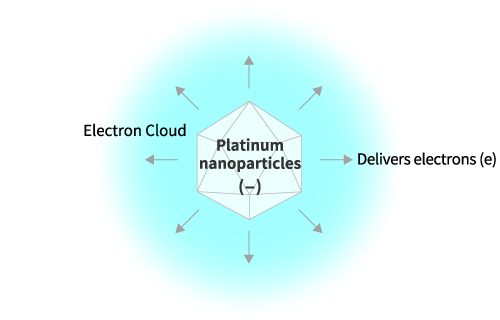What are Platinum Nanoparticles?
- Why Platinum Can Be Consumed
-
Gold and platinum are known as precious metals on Earth. Both have a common property that distinguishes them from other metals: they are extremely resistant to oxidation. Therefore, they do not change or rust within the body. Historically, people have known this property, which is why gold flakes have been used in health foods, mixed into drinks, and placed on food.

The platinum contained in "sai®" is surrounded by a cloud of electrons (e) and is excreted from the body along with feces after consumption. Therefore, platinum does not remain in the body, making it safe to drink.
Because of these special properties, gold and platinum are approved for use in food by the Ministry of Health, Labour and Welfare.
- What is the Mystical "Icosahedron"?
-
The platinum in "sai®" differs from the platinum used in rings and necklaces; it is reduced to very small platinum nanoparticles.
It has been discovered that when platinum is reduced to a very small size, the clusters of platinum atoms form a molecular structure known as a "regular icosahedron."The icosahedron is one of the only five Platonic solids that exist in this world and has the most faces of any regular polyhedron in three-dimensional space, with 12 vertices.
The ancient Greek philosopher Plato described regular polyhedra as fundamental shapes that support the universe, and icosahedra have been recognized since ancient times as forms that generate energy, even influencing the concept of pyramid power.
Among them, the regular icosahedron is shaped according to the "golden ratio," which mathematicians refer to as the "divine proportion" or the "most beautiful ratio."
- Platinum Comes from Space
Today, the platinum (white gold) found on Earth is collected from layers formed by a meteorite impact approximately 65 million years ago. This precious metal is so rare that only about 3 grams can be extracted from a ton of raw ore.
With its distant origins and having traveled across time and space, platinum, which shines with a noble white luster and never rusts, has become a symbol of eternal love, commonly used in wedding rings.
- Electrical Potential Similar to Human Cells
Platinum nanoparticles possess remarkable properties not found in platinum itself, specifically "electrical properties."
When platinum is reduced to a small size, the atoms cluster into icosahedral shapes. The increased number of surface platinum atoms means more electrons appear on the surface, surrounding the platinum nanoparticles with an "electron cloud."
During the production of "sai®," the platinum nanoparticles acquire an electrical potential (electric force).
The potential of platinum nanoparticles is -40mV.
This value is very close to the potential difference of healthy cells, and consuming platinum nanoparticles can help balance the body's cells. Moreover, while in the body, they continuously provide potential to the body.
- Why is "sai®" Black?
When metals are in nanoparticle form and dispersed in a colloidal state (appearing dissolved in water), their color is determined. Gold appears red to purple, silver appears yellow, and platinum appears brown.
This is because the electrons around the metal nanoparticles interact with light, and the difference in the wavelength of light they absorb results in different colors.
Originally, platinum colloid should appear brown, but "sai®" appears black because it contains a high concentration of platinum nanoparticles.
The consistent black appearance also proves that the platinum nanoparticles are stably dispersed. The particles have potential and repel each other, preventing precipitation and appearing uniformly black.
- Why Does it Emit Light?
Experiments in 2005 revealed that "sai®" emits photons (light particles). Although it appears black, it actually emits light.
This phenomenon is believed to occur because the platinum forms icosahedral structures, gathering vast amounts of electrons that emit photons and cause luminescence.
Therefore, "sai®" is truly "water that emits light," bringing light into the body.
- What is "Drinkable Music®"?
In 2012, a study by the Faculty of Liberal Arts at Tokyo City University detected sounds emitted by "sai®."
As water that carries potential and emits light, "sai®" is also considered "Drinkable Music®." With its unique electrical, optical, and acoustic properties, "sai®" has garnered significant interest from experts.
Recent advancements in physics have revealed that all subatomic particles vibrate at intrinsic frequencies in the unseen microscopic realm. In the visible larger world, the human body also maintains rhythms through breathing and heartbeat.
In music therapy, sound is regarded as a crucial element connecting the mind and body, and the conscious and unconscious. Sound is believed to be received not only through the auditory organs but also through the skin. The potential of sound is expected to attract even more attention in the future.